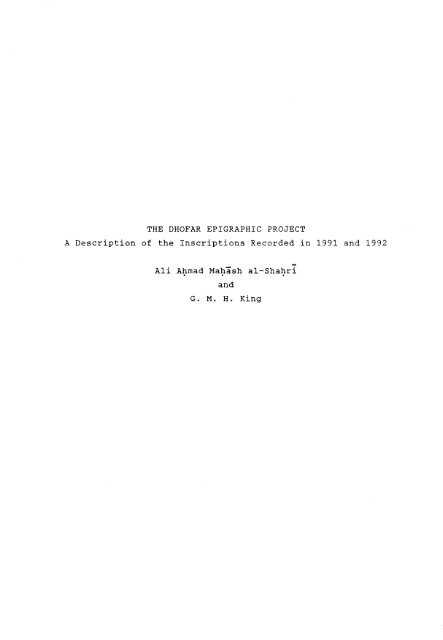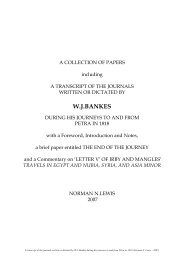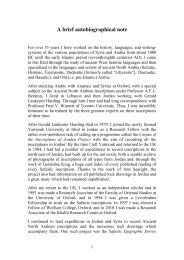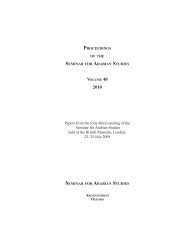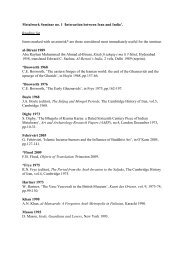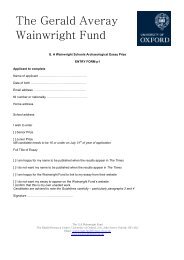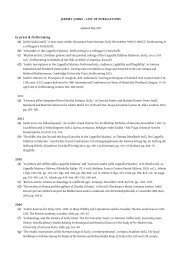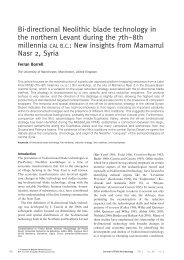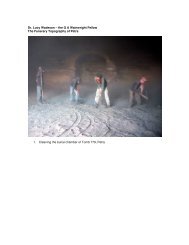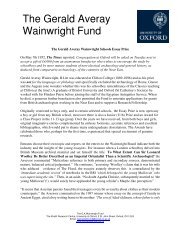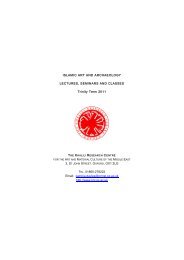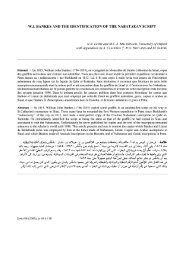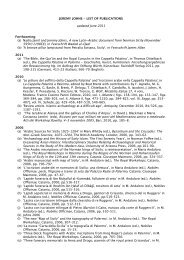THE DHOFAR EPIGRAPHIC PROJECT A Description of the ...
THE DHOFAR EPIGRAPHIC PROJECT A Description of the ...
THE DHOFAR EPIGRAPHIC PROJECT A Description of the ...
You also want an ePaper? Increase the reach of your titles
YUMPU automatically turns print PDFs into web optimized ePapers that Google loves.
Tables 1 - 2 ................................. 482 - 483<br />
Append ix 1 ........ '" ........ flO '" ...... '" .. '" .......... '" ...... '" "" ........ '" ...... 484<br />
Appendix 2 .......................... .,. ...................................... '" .. 485<br />
Bibliography .................................. 486 - 487<br />
Abbreviations ................................. 488 - 489<br />
Maps 1 - 8<br />
Figures 1 - 6 Script Table <strong>of</strong> Script 1<br />
Figures 7 - 9 Script Table <strong>of</strong> Script 2<br />
Figures 10 - 100 Facsimiles <strong>of</strong> <strong>the</strong> Inscriptions<br />
Plates<br />
iv
inscriptions found in <strong>the</strong> area <strong>of</strong> <strong>the</strong> Northwest Wadi Hadramawt<br />
suggest that similar inscriptions are found <strong>the</strong>re and, recently,<br />
it has been reported that similar scripts have been found in <strong>the</strong><br />
Mahrah region <strong>of</strong> <strong>the</strong> Republic <strong>of</strong> <strong>the</strong> Yemen 2 . A few inscriptions<br />
•<br />
published from Socotra suggest that <strong>the</strong> same, or a closely<br />
related script, was used <strong>the</strong>re as well (Doe 1970: 5, Figs. 8 -<br />
10) .<br />
The inscriptions in<br />
tantalising and fustrating as<br />
letters to those occurring in<br />
suggests that decipherment and<br />
. .<br />
§ 1<br />
both types <strong>of</strong> script are<br />
<strong>the</strong> similari ty <strong>of</strong> many <strong>of</strong> <strong>the</strong><br />
o<strong>the</strong>r South Semitic scripts,<br />
translation should not be a<br />
difficult task. Such optimism, however, has proved to be<br />
unfounded. The number <strong>of</strong> ambiguous forms and <strong>the</strong> nature <strong>of</strong> <strong>the</strong><br />
material has meant that, at this stage, whilst some evidence can<br />
be produced for <strong>the</strong> values <strong>of</strong> a few letters, at least in Script<br />
1, little <strong>of</strong> it is satisfactory or conclusive. The aim <strong>of</strong> <strong>the</strong><br />
present publication is to make <strong>the</strong> material available to<br />
scholars so that <strong>the</strong>y are aware <strong>of</strong> <strong>the</strong> inscriptions and are able<br />
to work on <strong>the</strong>m. We have limited ourselves to a description <strong>of</strong><br />
<strong>the</strong> texts and some remarks that we feel that can be made after a<br />
preliminary analysis <strong>of</strong> <strong>the</strong> sequences and various attempts at<br />
assigning values to <strong>the</strong> letter forms.<br />
NOTES:<br />
1Mr Mahash has suggested that <strong>the</strong>se structures should be called<br />
•<br />
"tetraliths" as <strong>the</strong>y usually consist <strong>of</strong> four stones, three<br />
standing upright and a fourth placed as a "capstone" on top.<br />
.<br />
See al-Shahri 1991a: 188 - 194 .<br />
2Verbal communication with Pr<strong>of</strong>essor Mikhail Piotrovsky.<br />
2
§ 2. The Area<br />
A general description <strong>of</strong> Dh<strong>of</strong>ar and<br />
geographical zones is given by Mr Mahash in<br />
•<br />
(al-Shahri . - 1991: 173 174, Pl. la) and he<br />
-<br />
distribution <strong>of</strong> his finds (al-Shahri 1991:<br />
•<br />
§ 2<br />
The regions where inscriptions were recorded have been<br />
divided up into 10 areas. In <strong>the</strong> eastern Jebel <strong>the</strong>se divisions<br />
are based largely on <strong>the</strong> asphalt roads running north to south<br />
and west to east through <strong>the</strong> Jebel (see Map 1). Each area has<br />
been given a capital letter and are defined as follows:<br />
Area A - to <strong>the</strong> west <strong>of</strong> <strong>the</strong> Teetam . . road (Map 2)<br />
Area B - between <strong>the</strong> Teetam and Thamrayt roads (Map 3)<br />
• •<br />
Area C - between <strong>the</strong> Thamrayt and Wadi Arzat roads (Map 4)<br />
Area D - between <strong>the</strong> Wadi Arzat and Medinat al-Haq roads (Map<br />
5)<br />
Area E - between <strong>the</strong> Medinat al-Haq road and <strong>the</strong> town <strong>of</strong> Tawi<br />
•<br />
Atir (Map 6)<br />
Area F - south <strong>of</strong> <strong>the</strong> Tawi Atir and Taqah roads (Map 6)<br />
•<br />
Area G - to <strong>the</strong> East <strong>of</strong> Tawi Atir (Map 7)<br />
Area H - <strong>the</strong> western Jebel (Map 8)<br />
Area I - <strong>the</strong> Negd in <strong>the</strong> western region<br />
Area J - <strong>the</strong> Negd in <strong>the</strong> eastern region to <strong>the</strong> east <strong>of</strong> <strong>the</strong><br />
Thamrayt road.<br />
The sites in Areas I and J are not marked on <strong>the</strong> maps.<br />
3<br />
.
§ 3. The Numbering <strong>of</strong> <strong>the</strong> Inscriptions.<br />
§ 3<br />
Within each area, <strong>the</strong> sites have been numbered, A1, A2,<br />
A3 etc., B1, B2, B3, etc. The inscriptions have been given <strong>the</strong><br />
siglum K(ing) M(ahash), followed by <strong>the</strong> letter designating <strong>the</strong><br />
•<br />
area in which it was found, KMA, KMB, KMC etc., and <strong>the</strong>n<br />
numbered in a continuous series for each area, so, for example,<br />
KMA 1 - 4 come from Site A2, KMA 5 - 25 from A3, KMB 1 - 18 come<br />
from Site B1, KMB 19 - 48 from Site B2 and so on.<br />
The horizontal texts written in Script 2 have been<br />
prefixed in <strong>the</strong> same way, so that it is easy see which area <strong>the</strong>y<br />
come from, and an H (orizontal) has been added to distinguish<br />
<strong>the</strong>m from <strong>the</strong> vertical texts. They are numbered in a separate<br />
series, KMAH 1 (Site A1), KMBH 1 - 7 (Site B5) and so on.<br />
Each line <strong>of</strong> <strong>the</strong> vertical script has been given a<br />
number regardless <strong>of</strong> <strong>the</strong> possibility that two or more lines<br />
wri tten close to each o<strong>the</strong>r might be <strong>the</strong> continuation <strong>of</strong> one<br />
text. In a few instances, <strong>the</strong> letters a, b, c, have been added<br />
to rectify mistakes made in <strong>the</strong> initial numbering <strong>of</strong> <strong>the</strong><br />
inscriptions (see KMB 67a - c, RMD 27a - b, RMD 48a - c, RME 66a<br />
- b, RME 125a, KME 160a, KMH 28a, KMJ 21a).<br />
For <strong>the</strong> texts in <strong>the</strong> horizontal script, where it seems<br />
most likely that closely wri tten lines constitute one<br />
inscription, <strong>the</strong> groups have been given only one number and <strong>the</strong><br />
individual lines distinguished by <strong>the</strong> letter a, b, c, d etc.<br />
The text in a form <strong>of</strong> <strong>the</strong> Monumental South Arabian<br />
Script has been given <strong>the</strong> siglum KMSA.<br />
4
§ 6.<br />
6.1.<br />
Script 1.<br />
The Transliteration <strong>of</strong> <strong>the</strong> Inscriptions.<br />
Many <strong>of</strong> <strong>the</strong> forms <strong>of</strong> <strong>the</strong> letters <strong>of</strong> <strong>the</strong> inscriptions<br />
are similar to graphemes found in inscriptions written in o<strong>the</strong>r<br />
South Semitic scripts and it is tempting to assume <strong>the</strong> letters<br />
have <strong>the</strong> same values here. By assigning values to <strong>the</strong> letters on<br />
<strong>the</strong> basis <strong>of</strong> comparisons <strong>of</strong> letters in o<strong>the</strong>r scripts, it is<br />
possible, with some <strong>of</strong> <strong>the</strong> shorter lines, to identify roots that<br />
occur in Arabic. An obvious interpretation <strong>of</strong> <strong>the</strong>m would be that<br />
<strong>the</strong>y are personal names.<br />
Short texts and such interpretations do not, however,<br />
prove <strong>the</strong> value <strong>of</strong> <strong>the</strong> letters and difficulties are encountered<br />
when trying to establish <strong>the</strong> values <strong>of</strong> more ambiguous forms.<br />
Fur<strong>the</strong>rmore, <strong>the</strong> longer inscriptions, where <strong>the</strong>re is some<br />
context, have not, at this stage <strong>of</strong> analysis, provided<br />
conclusive evidence for <strong>the</strong> values <strong>of</strong> ei<strong>the</strong>r familiar forms or<br />
<strong>the</strong> less common ones.<br />
For <strong>the</strong>se reasons r no attempt has been made in <strong>the</strong><br />
edi tion to attribute etymological or phonemic values to <strong>the</strong><br />
letters and <strong>the</strong> inscriptions in both Scripts 1 and 2 have simply<br />
been transliterated into two separate fonts which represent, in<br />
standardized forms, <strong>the</strong> original shapes <strong>of</strong> <strong>the</strong> letters.<br />
Table 1 is a chart <strong>of</strong> <strong>the</strong> typed forms in Script 1. The<br />
forms are arranged according to shape, reading from left to<br />
right and down <strong>the</strong> page. Underneath each form are <strong>the</strong> number <strong>of</strong><br />
attested examples. Figures 1 - 6 is a script table <strong>of</strong> Script 1<br />
wi th examples <strong>of</strong> <strong>the</strong> letters represented by each typed forms.<br />
The last two columns <strong>of</strong> Figure 6 give some anomalous forms which<br />
have not been transliterated into <strong>the</strong> typed script.<br />
Most <strong>of</strong> <strong>the</strong> texts in Script 1 are wri tten vertically<br />
8<br />
§ 6
6.2. Script 1 - The Letters.<br />
§ 6<br />
This section lists <strong>the</strong> typed forms <strong>of</strong> <strong>the</strong> letters with<br />
<strong>the</strong> number <strong>of</strong> attested examples given in brackets, comments on<br />
<strong>the</strong> forms found in <strong>the</strong> inscriptions and gives comparative<br />
examples from o<strong>the</strong>r South Semitic scripts. The comparative<br />
examples are, on <strong>the</strong> whole, from scripts which are<br />
well-established or from texts where <strong>the</strong> reading is certain. The<br />
script table in Jamme 1963: 43, Fig. 1 <strong>of</strong> inscriptions from Wadi<br />
Hadramawt, al-Wastah and al-tAbar, in <strong>the</strong> Repuplic <strong>of</strong> Yemen show<br />
f ., ••<br />
many forms <strong>of</strong> letters which<br />
2. Unfortunately, however,<br />
resemble those found in Script 1 and<br />
<strong>the</strong> author has not published any<br />
copies or photographs <strong>of</strong> <strong>the</strong> inscriptions in <strong>the</strong> article and so<br />
his remarks about <strong>the</strong> values <strong>of</strong> <strong>the</strong> letters cannot be checked.<br />
In some cases <strong>the</strong> great variety <strong>of</strong> letters listed under one<br />
value suggest that perhaps he is dealing with more than one<br />
script or that he has mistakenly identified <strong>the</strong> values <strong>of</strong> some<br />
<strong>of</strong> <strong>the</strong> forms. Many <strong>of</strong> <strong>the</strong> signs listed as wusum by Jamme (1963:<br />
47, Fig. 2) also resemble forms <strong>of</strong> letters found in both <strong>the</strong><br />
scripts from Dh<strong>of</strong>ar.<br />
6.2.1. [<br />
(419)<br />
The forms <strong>of</strong> [ are similar to those used in Sabaic<br />
(Beeston 1984: 4), Safaitic, Thamudic E, Thamudic B, Dedanite,<br />
North Minaic (Macdonald 1992: 419) and Lihyanite (Caskel 1954:<br />
33 - 34) to represent b and <strong>the</strong>re is evidence from sequences in<br />
<strong>the</strong> texts that it has <strong>the</strong> same value here, see § 6.3.7.<br />
6.2.2. J<br />
(60)<br />
examples <strong>of</strong> [.<br />
The curve <strong>of</strong> J is less than that <strong>of</strong> most <strong>of</strong> <strong>the</strong><br />
12
6.2.3. J<br />
(14)<br />
6 . 2 . 4 . U<br />
(6 )<br />
6.2.5. U<br />
(20)<br />
6.2.6. <<br />
(168)<br />
§ 6<br />
The forms <strong>of</strong> < are similar to those used in Dedanite,<br />
North Minaic (Macdonald 1992: 419, 5 - 6) and Lihyanite (Caskel<br />
1954: 33 - 34) to represent r and to those used in Safaitic<br />
(Macdonald 1992: 419, 1 - 2) and, in some cases, Thamudic E<br />
1<br />
(King 1990: Fig. 4) to represent s. There is a degree <strong>of</strong><br />
evidence from <strong>the</strong> sequences that, at least in some instances,<br />
<strong>the</strong> form has <strong>the</strong> value b in <strong>the</strong>se texts, see § 6.3.8.<br />
6.2.7. ><br />
(21)<br />
It is possible that > is <strong>the</strong> same grapheme as
oval shape is used in Safai tic and Thamudic B to represent g<br />
(Macdonald 1992: 419, 2) and a near circle in North Minaic to<br />
represent f (Macdonald 1992: 419, 6).See § 6.3.6f for comments<br />
on 0 and e and see § 6.6.5.<br />
6.2.33. []<br />
(28)<br />
6.2.34. e<br />
(198)<br />
§ 6<br />
A circle with a dot in <strong>the</strong> middle is occasionally used<br />
in Thamudic E to represent C and a larger circle with a dot very<br />
occasionally represents Q (King 1990: Fig. 3, KJA 138, and Fig.<br />
5, KJA 64). See § 6.3.6f for comments on 0 and e.<br />
6.2.35. 8<br />
(280)<br />
The letter resembles <strong>the</strong> form <strong>of</strong> w in Sabaic (Beeston<br />
1984: 4), Lihyanite (Caskel 1954: 33 - 34), Safaitic, Thamudic<br />
E, Thamudic B, Dedanite and North Minaic (Macdonald 1992: 419, 1<br />
- 6).<br />
6.2.36. IB<br />
(29)<br />
The letter is very occasionally used to represent w in<br />
Thamudic E (King 1990: Fig. 6, KJC 408).<br />
6.2.37. 6<br />
(266)<br />
The form resembles <strong>the</strong> grapheme y in Sabaic (Beeston<br />
1984: 4), Lihyanite (Caskel 1954: 33 - 34), Safaitic, Thamudic<br />
E, Thamudic B, Dedanite and North Minaic (Macdonald 1992: 419, 1<br />
- 6). See §§ 6.4.3 - 4.<br />
18
(403)<br />
§ 6<br />
It seems likely from <strong>the</strong> number <strong>of</strong> texts in which - and<br />
occur toge<strong>the</strong>r, that <strong>the</strong> two forms have a different value<br />
ra<strong>the</strong>r than being <strong>the</strong> same grapheme with a different stance. See<br />
§ 6.2.49.<br />
6.2.49.<br />
(139)<br />
See § 6.2.48. A straight line is used to represent 1 in<br />
Safai tic (Macdonald 1992: 419, 2), n in Thamudic B (Macdonald<br />
1992: 419, 4), r in Thamudic D (Winnett 1937: Plate X), S2 in<br />
Thamudic E (King 1990: Fig. 4, Macdonald 1992: 419, 3).<br />
6.2.50. -....<br />
(192)<br />
6.2.51. II<br />
(13)<br />
Three <strong>of</strong> <strong>the</strong> examples <strong>of</strong> II are doubtful and two <strong>of</strong> <strong>the</strong><br />
texts (KMB 11 and 67c) are written horizontally. Although <strong>the</strong><br />
stance <strong>of</strong> some <strong>of</strong> <strong>the</strong> o<strong>the</strong>r letters in <strong>the</strong>se texts has been<br />
changed, it seems likely that <strong>the</strong> vertical stance <strong>of</strong> = has been<br />
kept. It is possible that some <strong>of</strong> <strong>the</strong> examples <strong>of</strong> II should be<br />
interpreted as a sequence <strong>of</strong> I and I.<br />
6.2.52. -- (92)<br />
6.2.53. III<br />
( 4)<br />
One <strong>of</strong> <strong>the</strong> attested examples <strong>of</strong> III stands alone and two<br />
<strong>of</strong> <strong>the</strong> o<strong>the</strong>r examples occur in KMB 67c which is written<br />
horizontally where it seems likely that <strong>the</strong> stance used in<br />
vertical texts has been kept. Cf. II in § 6.2.51.<br />
21
§ 6<br />
The number <strong>of</strong> forms distinguished in <strong>the</strong> inscriptions<br />
in Script 1 is 80, which greatly exceeds <strong>the</strong> numbers <strong>of</strong><br />
consonants in any <strong>of</strong> <strong>the</strong>se languages and this is clearly<br />
because, at this stage, it has not been possible to identify<br />
which forms are variations <strong>of</strong> <strong>the</strong> same grapheme. There is<br />
evidence from <strong>the</strong> sequences to reduce <strong>the</strong> number by 5 and<br />
possibly 6 24 , and fur<strong>the</strong>r reductions would certainly be valid but<br />
it is difficult to prove <strong>the</strong>m at <strong>the</strong> moment. There are several<br />
hypo<strong>the</strong>tical ways <strong>of</strong> reducing <strong>the</strong> alphabet, one possibility is<br />
given in Appendix 1 which reduces <strong>the</strong> number <strong>of</strong> letters to 37.<br />
Two fur<strong>the</strong>r points should be made. Firstly, we do not<br />
know at this stage whe<strong>the</strong>r we have <strong>the</strong> full complement <strong>of</strong> <strong>the</strong><br />
graphemes in <strong>the</strong> alphabet 25 and, secondly, some forms in <strong>the</strong><br />
script table which have been identified with similar forms might<br />
26<br />
actually belong elsewhere .<br />
6.6. The Values <strong>of</strong> <strong>the</strong> Graphemes.<br />
6.6.1. Some evidence has been given for assigning <strong>the</strong><br />
following values to a few forms:<br />
J<br />
a<br />
b<br />
t<br />
1<br />
n<br />
y<br />
t<br />
c<br />
+<br />
Forms similar to 0 and e occur across <strong>the</strong> whole<br />
spectrum <strong>of</strong> <strong>the</strong> South Semi tic scripts wi th <strong>the</strong> values q and w<br />
respectively and it is quite likely <strong>the</strong>y have maintained those<br />
values here.<br />
38
§ 7. Script 2.<br />
§ 7<br />
Texts written in Script 2 come from <strong>the</strong> following sites:<br />
Site Ai KMAH la - le<br />
Site B5 KMBH 1 - 7<br />
Site D3 KMDH 1 - 3<br />
Site Dll KMDH 4 - 6<br />
Site El0 KMEH la - ld<br />
Site E27 KMEH 2a - 6b<br />
Site G2 KMGH 1<br />
Site G4 KMGH 2<br />
Site G5 KMGH 3a - 4<br />
Site G7 KMGH 5 - 10<br />
Site G12 KMGH 11 - 12<br />
Site G21 KMGH 13 - 14<br />
Site H2 KMHH 1a - 6b<br />
Site H3 KMHH 7a - 13d<br />
Site H4 KMHH 14a - 20e<br />
Site H5 KMHH 21a - 31c<br />
Site H6 KMHH 32 - 35d<br />
Site H7 KMHH 36a - KMHH 48b<br />
Site Ii KMIH 1 - 3<br />
7.1- The Transliteration <strong>of</strong> <strong>the</strong> Inscriptions.<br />
As with Script 1 , <strong>the</strong> texts have been transliterated<br />
into typed forms <strong>of</strong> <strong>the</strong> original letters. Table 2 is a chart <strong>of</strong><br />
<strong>the</strong> forms arranged according to shape and reading left to right<br />
across <strong>the</strong> page and <strong>the</strong>n down. The number <strong>of</strong> attested examples<br />
is given in brackets. Figures 7 - 9 give examples <strong>of</strong> <strong>the</strong> signs<br />
represented by <strong>the</strong> typed forms. All <strong>the</strong> inscriptions are written<br />
horizontally, except for KMB 1 - 5 (Site B5) where <strong>the</strong> letters<br />
have been turned on <strong>the</strong>ir side and read downwards. The ductus <strong>of</strong><br />
some <strong>of</strong> <strong>the</strong> letters shows that some <strong>of</strong> <strong>the</strong> texts read from right<br />
to left and some from left to right and different typed forms<br />
have been used for <strong>the</strong> following:<br />
43
7.2.26. 0<br />
(11)<br />
7.2.27. 0<br />
( 4 )<br />
The examples <strong>of</strong> this letter (KMEH 4d, 6b, 20d, 35a) are<br />
doubtful. A diamond shape represents f in Sabaic (Beeston 1984:<br />
4) •<br />
7.2.28. B<br />
(4 )<br />
All <strong>the</strong> examples <strong>of</strong> this letter come from <strong>the</strong> same<br />
si te, H6, and three <strong>of</strong> <strong>the</strong>m from <strong>the</strong> same inscription (KMHH<br />
34d). A similar form represents rJ in Sabaic (Beeston 1984: 4)<br />
Lihyani te (Caskel 1954: 33 - 34) and North Minaic (Macdonald<br />
1992: 419, 6). It is possible that <strong>the</strong> form is a variation <strong>of</strong> a,<br />
see 7.2.30.<br />
7.2.29. m<br />
( 4)<br />
One example <strong>of</strong> <strong>the</strong> letter is doubtful (KMGH 10). The<br />
form resembles that used to represent t in Sabaic (Beeston 1984:<br />
4) and North Minaic (Macdonald 1992: 419, 6). It is possible<br />
that <strong>the</strong> form is a variation <strong>of</strong> a, see § 7.2.30.<br />
7.2.30. e<br />
(72)<br />
§ 6.2.35.<br />
7.2.31. 9)<br />
The form resembles <strong>the</strong> grapheme w found elsewhere, see<br />
(14)<br />
See § 6.2.36.<br />
48<br />
§ 7
is perhaps a sign resembling <strong>the</strong> form used to represent $ in<br />
Sabaic (Beeston 1984:4), Safaitic (Macdonald 1992: 419, 2) and<br />
Thamudic E (King 1990: Fig. 4), with <strong>the</strong> circle on <strong>the</strong> top <strong>of</strong><br />
<strong>the</strong> fork filled in.<br />
7.2.39. S'::<br />
( 1 )<br />
§ 7<br />
The form resembles <strong>the</strong> grapheme $ in North Minaic<br />
(Macdonald 1992: 419, 6). Jamme 1963: 43, Fig. 1, 11. 2a - b<br />
lists similar signs which he gives <strong>the</strong> value $.<br />
7.2.40. '/I..<br />
(1)<br />
For <strong>the</strong> reading <strong>of</strong> similar forms from elsewhere with<br />
<strong>the</strong> values $2, Q and $3, see § 6.2.46.<br />
7.2.41. •<br />
( 1 )<br />
The reading <strong>of</strong> this letter (KMEH 4g) is doubtful, it is<br />
possible that it is all that remains <strong>of</strong> ano<strong>the</strong>r letter. Cf. §<br />
6.2.47.<br />
7.2.42.<br />
(104)<br />
For <strong>the</strong> values <strong>of</strong> a grapheme <strong>of</strong> a straight line in<br />
o<strong>the</strong>r scripts, see § 6.2.49. There is evidence from <strong>the</strong><br />
sequences that it is used here as a word divider, see § 7.3.1.<br />
There are some instances (KMHH 17, 26b, 28b, 39b 40a, 40b) where<br />
<strong>the</strong>re is a combination <strong>of</strong> two lines written toge<strong>the</strong>r and it is<br />
possible <strong>the</strong>y should be interpreted as one sign, cf. = and II in<br />
Script 1, §§ 6.2.50 and 6.2.51.<br />
7.2.43.<br />
(21)<br />
50
Eight <strong>of</strong> <strong>the</strong> examples <strong>of</strong> t come from Site H6.<br />
There is evidence that it performs <strong>the</strong> function <strong>of</strong> a word<br />
divider, cf. § 7.2.42 and see § 7.3.1.<br />
7.2.44. III<br />
( 2 )<br />
Cf. § 6.2.52 and § 6.2.53.<br />
7.2.45. r 1<br />
(17) (52)<br />
§ 6.2.55.<br />
7.2.46. 1<br />
§ 7<br />
The form resembles <strong>the</strong> grapheme 1 found elsewhere, see<br />
(11)<br />
A similar form is used in Sabaic and North Minaic to<br />
represent g, see § 6.2.56.<br />
7.2.47. T<br />
7.2.48. H<br />
( 1 )<br />
The reading <strong>of</strong> this letter is doubtful, cf. § 6. 2.57.<br />
(15 )<br />
The form resembles <strong>the</strong> grapheme d in Taymanite, see §<br />
6.2.58, for o<strong>the</strong>r comparisons.<br />
7.2.49. +<br />
(16)<br />
The form resembles <strong>the</strong> grapheme t in Thamudic B, see §<br />
6.2.60, for o<strong>the</strong>r comparisons. It is probably <strong>the</strong> same grapheme<br />
as X, written with a different stance, see § 7.2.50.<br />
7.2.50. X<br />
51
doubtful example in Script 1.<br />
58<br />
§ 8
§ 9. The Drawings.<br />
Mr Mahash has found many drawings painted in <strong>the</strong> caves<br />
•<br />
and inscribed on rocks in <strong>the</strong> desert areas (see al-ShaI:ri 1991:<br />
180 - 184). As <strong>the</strong> fieldwork <strong>of</strong> <strong>the</strong> Dh<strong>of</strong>ar Epigraphic Project in<br />
1991 and 1992 was primarily concerned with <strong>the</strong> inscriptions, very<br />
few <strong>of</strong> <strong>the</strong> drawings were recorded and only some <strong>of</strong> <strong>the</strong>se have been<br />
mentioned in <strong>the</strong> edition and included in <strong>the</strong> facsimiles. The same<br />
siglum has been used for <strong>the</strong> drawings followed by dr (awing). A<br />
number <strong>of</strong> <strong>the</strong> inscriptions are accompanied by handprints and some<br />
are covered by dots. The following is a list <strong>of</strong> <strong>the</strong> subjects which<br />
are depicted:<br />
Camels<br />
Camels with riders<br />
Circle with grid<br />
Cows<br />
Dots<br />
Handprints<br />
Horses<br />
Ibex<br />
Men<br />
Men on horseback<br />
Mules<br />
Ships<br />
Trees<br />
Unidentified animals<br />
Unidentified drawings<br />
§ 9<br />
KMDdr 3, KMEdr 5, 7, 8, KMGdr 2,<br />
10<br />
Unidentified horned animals<br />
Women<br />
59<br />
KMDdr 11<br />
KMEdr 3<br />
KMHdr 2, 3, 8 ?<br />
See KMD 121 - 130, KME 73 - 74,<br />
KMCdr 1 - 2, KMDdr 1, 5, KMEdr<br />
1, KMGdr 4, 5<br />
KMAdr1, KMDdr 2 ?<br />
KMEdr 4, KMGdr 6, 9, KMHdr 6<br />
KMBdr 1, KMDdr 4, 6, KMEdr 2,<br />
9, KMGdr 1, 3, KMHdr 4, 5, 7 ,<br />
9<br />
KMCdr 4, KMCdr 5, KMGdr 7, 8,<br />
KMDdr 2 ?<br />
KMHdr 1<br />
KMGdr 12<br />
KMCdr 3, KMEdr 6<br />
KMEdr 3<br />
KMEdr 4<br />
KMHdr 7<br />
6 ,<br />
8 I
BIBLIOGRAPHY<br />
Albright, F. P. 1982 The American Archaeological Expedition in<br />
Dh<strong>of</strong>ar, Oman, 1952 - 1953, Publications <strong>of</strong> <strong>the</strong> American<br />
Foundation for <strong>the</strong> Study <strong>of</strong> Man, Volume VI, Washington<br />
DC.<br />
Beeston, A. F. L. 1976 'The Settlement at Khor Rori'. Journal <strong>of</strong><br />
Oman Studies, 2: 39 - 42.<br />
1984 Sabaic Grammar. Journal <strong>of</strong> Semitic Studies<br />
Monograph No.6., Manchester.<br />
Branden van den, A. 1956 Les Textes Thamoudeens de Philby, I,<br />
Biblio<strong>the</strong>que du Museon, 40. Louvain.<br />
Caskel, W. 1954 Lihyan und Lihyanisch. Arbei tsgemeinschaft f tir<br />
Forschung des Landes Nordhein-Westfalen, Heft 4. Koln<br />
und Opladen.<br />
Doe, D. Brian 1970 'Socotra, An Archaeological Reconnaissance in<br />
1967', H. Field and E. M. Laird eds., Field Research<br />
Projects, Coconut Grove, Miami, Florida.<br />
Harding, G. L. 1971 An Index and Concordance <strong>of</strong> Pre-Islamic<br />
Names and Inscription. Toronto.<br />
Jamme, A. 1963 'Preliminary Report on Epigraphic Research in<br />
North-Western Wadi Hadramawt and at al- Abar'. Bulletin<br />
<strong>of</strong> <strong>the</strong> American chools <strong>of</strong> Oriental Research, 72: 41 -<br />
54.<br />
Jaussen, A. and Savignac, R. 1909, 1914 Mission archeologique en<br />
Arabie. Vols. 1 - 2 and Atlas. Paris.<br />
Johnstone, T. M. 1981 Jibbali Lexicon. Oxford University Press.<br />
1987 Mehri Lexicon and English Mehri Word-List. School<br />
<strong>of</strong> Oriental and African Studies. London.<br />
King, G. M. H. 1990 Early North Arabian Thamudic E. Unpublished<br />
Ph.D. Thesis, School <strong>of</strong> Oriental and African Studies,<br />
London.<br />
Macdonald, M. C. A. 1991 'HU 501 and <strong>the</strong> Use <strong>of</strong> S3 in<br />
Taymanite' Journal <strong>of</strong> Semitic Studies, 36, No.1: 11 -<br />
36.<br />
1992 'Safaitic Inscriptions' in D. N. Freedman ed. The<br />
486
Anchor Bible Dictionary, 3: 418 - 423<br />
Pirenne, J. 1975 'The Incense Port <strong>of</strong> Moscha (Khor Rori) in<br />
Dh<strong>of</strong>ar'. Journal <strong>of</strong> Oman Studies, 1: 81 - 96.<br />
Ryckmans, J. [no date] List <strong>of</strong> names in <strong>the</strong> 10, 000 unpublished<br />
Thamudic texts collected on <strong>the</strong> Ryckmans - Philby -<br />
Lippens Expedition<br />
to Saudi Arabia in 1952.<br />
Unpublished.<br />
al-Shahri, . Ali Ahmad . Mahash . 1991 'Recent Epigraphic Discoveries<br />
in Dh<strong>of</strong>ar'. Proceedings <strong>of</strong> <strong>the</strong> Seminar for Arabian<br />
Studies, 21: 173 - 191.<br />
1991a 'Grave-Types and "Triliths" in Dh<strong>of</strong>ar.' Arabian<br />
Archaeology and Epigraphy, 2: 182 - 195.<br />
Thesiger, W. 1959 Arabian Sands. London. Reprint Collins,<br />
Glasgow, 1983.<br />
Thomas, B. 1932 Arabia Felix: Across <strong>the</strong> Empty Quarter <strong>of</strong><br />
Arabia. London.<br />
Winnett, F. V. 1937 A Study <strong>of</strong> <strong>the</strong> Lihyanite and Thamudic<br />
Inscriptions. Toronto.<br />
and Harding, G. L. 1978 Inscriptions from Fifty<br />
Safaitic Cairns. Near and Middle East Series 9.<br />
Toronto.<br />
and Reed, W. L. 1970 Anci en t Records from North<br />
Arabia. Toronto.<br />
487
ABBREVIATIONS<br />
HIn Harding 1971.<br />
Ja South Arabian inscription read by Fa<strong>the</strong>r A. Jamme in<br />
Albright 1982.<br />
JS Thamudic inscriptions in Jaussen Savignac 1909, 1914.<br />
KJA Thamudic E inscriptions from Wadi Judayyid Site A in<br />
King 1990.<br />
KJB Thamudic E inscriptions from Wadi Judayyid Site B in<br />
King 1990.<br />
KJC Thamudic E inscriptions from Wadi Judayyid Site C in<br />
King 1990.<br />
KMA Inscriptions in Script 1 from Area A.<br />
KMAdr Drawings from Area A.<br />
KMAH Inscriptions in Script 2 from Area A.<br />
KMB Inscriptions in Script 1 from Area B.<br />
KMBdr Drawings from Area B.<br />
KMBH Inscriptions in Script 2 from Area B.<br />
KMC Inscriptions in Script 1 from Area C.<br />
KMCdr Drawings from Area C.<br />
KMD Inscriptions in Script 1 from Area D.<br />
KMDdr Drawings from Area D.<br />
KMDH Inscriptions in Script 2 from Area D.<br />
KME Inscriptions in Script 1 from Area E.<br />
KMEdr Drawings from Area E.<br />
KMEH Inscriptions in Script 2 from Area E.<br />
K11F Inscriptions in Script 1 from Area F.<br />
KMG Inscriptions in Script 1 from Area G.<br />
KMGdr Drawings from Area G.<br />
KMGH Inscriptions in Script 2 from Area G.<br />
KMH Inscriptions in Script 1 from Area H.<br />
KMHdr Drawings from Area H.<br />
KMHH Inscriptions in Script 2 from Area H.<br />
KMI Inscriptions in Script 1 from Area 1.<br />
KMIH Inscriptions in Script 2 from Area 1.<br />
KMJ Inscriptions in Script 1 from Area J.<br />
488
KMSA<br />
Ph<br />
Inscription in Sayhadic Script.<br />
Inscriptions in Van den Branden 1956.<br />
489
•••<br />
AREA D - DID 28 - 48<br />
0'<br />
f<br />
30<br />
Pig. 26<br />
-:-<br />
•<br />
31<br />
SITE D.2<br />
11_. J<br />
49<br />
50<br />
AREA D - KHD 48& - 65<br />
51<br />
4Be<br />
"<br />
0""<br />
.,l..<br />
-c::r-<br />
.J-<br />
,.<br />
.<br />
\'<br />
Fig. 27<br />
52<br />
.l- 53<br />
'" .- , ... , .......<br />
'-, . , -<br />
.,.c:7<br />
111111<br />
A-<br />
63<br />
54<br />
.L<br />
nn<br />
V<br />
.J..<br />
:J<br />
SITE D2
AREA H - KMHH 13a - 14c, KMH 48 _ 50<br />
Fig. 84<br />
SITE H4<br />
SITE HJ<br />
48 49<br />
II<br />
o<br />
'"<br />
•••<br />
• • • ::J<br />
--<br />
.-w-<br />
:<br />
...
1<br />
Pig. 94<br />
SITE Jl<br />
AREA J - ltMJ 7 - 19<br />
SIn Jl


